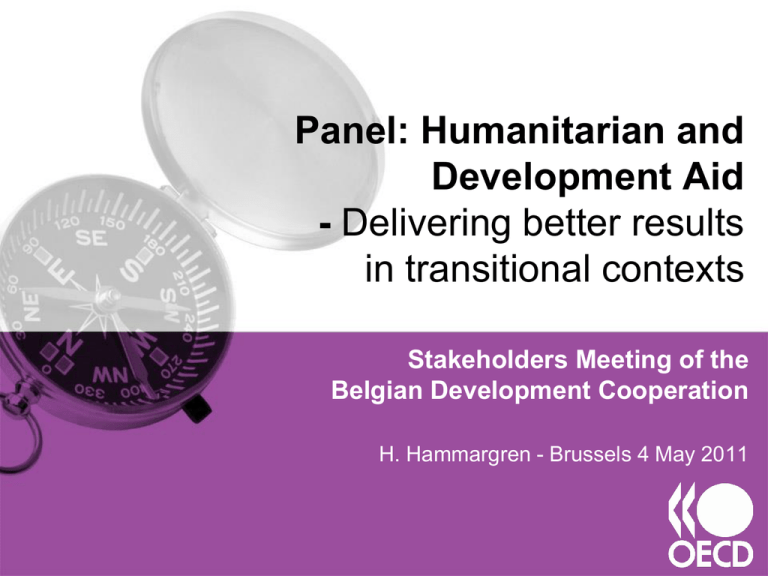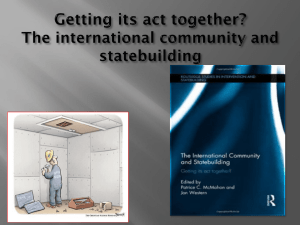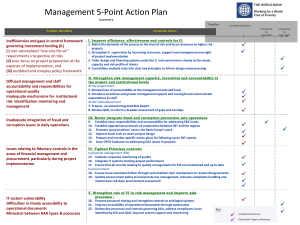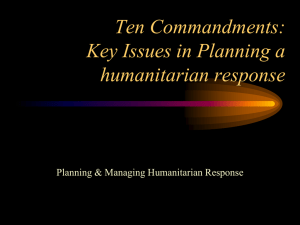Presentation Henrik Hammargen
advertisement

Panel: Humanitarian and Development Aid - Delivering better results in transitional contexts Stakeholders Meeting of the Belgian Development Cooperation H. Hammargren - Brussels 4 May 2011 Fragmented Aid architecture + Principles Background and rationale Background: • Aid modalities do not respond well to post-conflict transition • Commitments at High Level Forum on Aid Effectiveness in Accra • UN SG’s report on Peacebuilding Objective: • Review policies and procedures and existing funding instruments to identify challenges and lessons • Develop Guidance on how to improve the speed, flexibility and risk acceptance of transition financing • “I urge donors to be bold and innovative in finding solutions that will establish flexible, rapid and predictable funding modalities for countries emerging from conflict.” Ban Ki-moon, UN SG Conclusions – from initial work: • Change starting point and understanding of transition • Strengthen coordination and collaboration of international response to avoid fragmentation and competition • Address ownership - strengthen local capacity and systems to transfer aid “on-budget” and on national priorities • Prioritise known peacebuilding and statebuilding objectives • Sequence interventions based on absorptive capacity – gradual application of the Paris Declaration • Simplify and improve aid instruments and modalities – build on synergies • Encourage better risk management and acceptance – collective risk management • Change donor policies and behaviour Understanding Transition Shift from: • Focus on life-saving and humanitarian principles vs making explicit political choices establishing sustainable peace and viable state structures • Using ‘humanitarian’ vs ‘development’ aid modalities • Working with international organisations vs local partners Specific characteristics: • Longer-term and non-linear process • Shared space needed between humanitarian and development actors • Requires adaptable mix of resources and instruments, including ODA eligible and non-ODA funds • Requires flexible approach to national ownership and risk Towards OECD (?) guidance for Transition Financing – what to cover: • • • • • • Risk management Planning Prioritisation Aid instruments Aid Architecture Mutual Accountability & Transparency A new approach in managing risks Risk Management and Accountability Risk management • Adopt appropriate risk management and mitigation approaches – moving towards a an appropriate risk culture • Agree on terms and concepts to improve risk analysis and risk management • Promote collective approaches - pooled risk management • Communication and expectation management – accept high exposure to institutional risks • Make accountability and reporting requirements more realistic and better adopted to context Accountability • Establishment of accountability frameworks • Improve transparency in resource flows Transition Priority Areas Protection & Reintegration Service Delivery Statebuilding Political Processes Economic recovery & Employment Security and Justice National Priorities: Revenue and Budget process Transition Priorities Protection & Reintegration Humanitarian Action Service Delivery Statebuilding Specialised Funds Political Processes MDTF Economic recovery & Employment Security and Justice Program & Project Support Official Development Assistance (ODA) External Financing - Multi-and Bilateral Non-ODA Ownership and Planning: Ownership • Ensure strategic focus – statebuilding • Define the likely transition trajectory • Manage the transition – moving towards use of national systems • Provide immediate and flexible financing for processes and capacity development – strengthen and specialise global pooled funds Planning • Annual flexible plan based on realistic assumptions • Ensure strategic focus and prioritisation • Linking financing modalities to priorities • Coordination and expectation management / realistic results • Process management Aid Instruments • Manage transition and use instruments strategically • Specialise instruments to transition priorities • Improve effectiveness of pooled funding mechanisms – Address the time of establishment – Clarify and separate administrative functions (management, priority setting, and role of donors) – Reduce present overlap of funds • Ensure coordination between humanitarian and development funding instruments Aid Architecture Country / Global level • Adapt a Transition Compact as a point of departure for improving engagement • Strengthen coordination and leadership at country level • Increase flexibility between humanitarian and development policies and procedures • Address relationship between guiding principles • Clarify multilateral relationships • Agreeing on global peacebuilding and statebuilding framework Donors • Clarify responsibilities, strengthen engagement and risk approach • In-country division of labour among donors • Acknowledge role of non-ODA funds Establish a Transition Compact that: • Capture and clarify funding flows - humanitarian, developmental and peace and security related (including programmable non-ODA) • Identify actors and communities involved in transition activities and the relationships between them • Identify financing instruments and their governance structures • Relationship between funding flows/modalities and national priorities including the national budget process. • Follow an annual planning and monitoring process in relation to critical peace and statebuilding objectives – setting out realistic goals and milestones • Outline and promote gradual application of the Paris Declaration • Establish a framework for mutual accountability (Govt – development partners / between bilateral donors) to strengthen risk mitigation and transparancy A Transition compact – the proces: • It outlines and promotes a process for gradually strengthening and moving towards use of country systems • It sets a process of gradual planning based on agreed transitional objectives (to cover both humanitarian and developmental concerns – these should include protection, security, political dialogue, statebuilding, service delivery and development investments) • It assists in the selection and application of aid instruments to meet the prioritized objectives • It stimulates mutual approaches to risk management and accountability frameworks Key Challenges • Acceptance for gradual application of the Paris Declaration • Addressing aid architecture – management • Agree on set objectives / Transition Priority Areas • Setting “default positions” for aid instruments and their management • Establishing mutual accountability frameworks that address development results and effectiveness • Acceptance of differentiated risk management • Increased awareness of the purpose and use of security instruments – and the importance of use of non-ODA financing during transition









